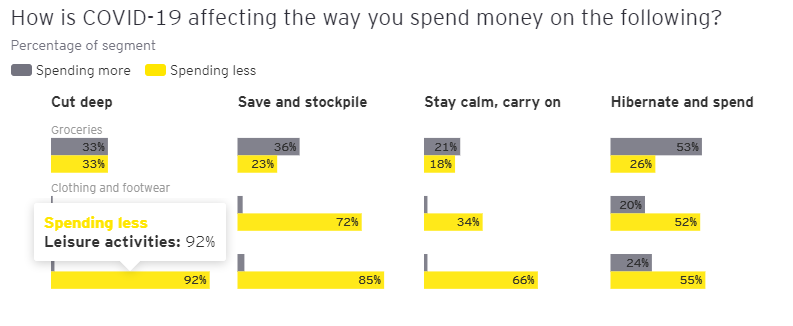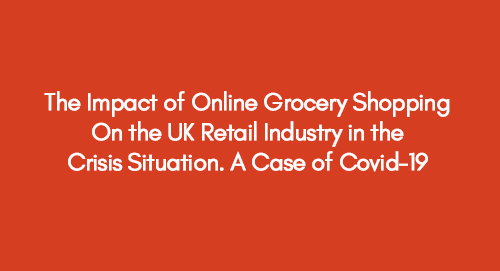How to analyse quantitative data for a dissertation
December 5, 2022
Comparison Between Islam and Christianity in Influencing the Gender Role of Women in the 21st Century
December 10, 2022Covid-19 fueled a surge in online grocery shopping, reshaping the UK retail industry. Traditional retailers swiftly embraced digital platforms, marking a lasting transformation in consumer behaviour and industry dynamics. In the wake of the unprecedented challenges posed by the COVID-19 pandemic, the UK retail industry underwent a transformative shift, finding itself at the epicentre of change. Social distancing measures and widespread lockdowns became the new norm, compelling consumers to reevaluate how they procure essential goods. This seismic shift in consumer behaviour propelled online grocery shopping into the spotlight as a pivotal solution, offering a safe and convenient alternative amidst the uncertainties of the crisis.
Impact of Digital Marketing in Generating a High Customer Base of Online Retailers
As social dynamics transformed, the traditional brick-and-mortar retail experience faced unparalleled challenges. The restrictions imposed by the pandemic prompted a radical evolution in how consumers approached their essential needs. In this new landscape, online grocery shopping emerged as a convenience and a lifeline, reshaping the contours of the UK retail industry and pushing businesses to swiftly adapt to the digital frontier to meet the growing demand for a safer and more accessible shopping experience.
Introduction
The internet's rapid evolution over the past two decades and innovations in the digital economy have significantly influenced the information technology industry (Clements, 2020). This development has paved the way for long-term advancements that profoundly impact internet users. Concurrently, the landscape of online shopping has undergone remarkable transformations, altering consumer purchasing behaviour significantly (Baker et al., 2020). The availability of diverse offers, enhanced accessibility, cashless transactions, and detailed product information has revolutionized the very essence of online shopping. Among various sectors, the retail industry, particularly in grocery shopping, stands out as a primary beneficiary of this paradigm shift (Feng, 2020).
While online grocery shopping is relatively recent, it has become an indispensable consumer service. This study aims to explore the impact of online shopping on the UK retail industry, especially amidst the current uncertainties posed by the COVID-19 pandemic—a global crisis causing widespread distress and uncertainty across all sectors (Friedrich, 2020). Daily routines are disrupted, presenting challenges in time management and accessibility for the general public. The demand for groceries, a fundamental necessity, faces obstacles due to lockdown situations (Rummo, 2020). Consequently, this research will explore how UK residents navigate grocery shopping through online services and assess the effect on the retail industry. Through an in-depth literature review, the study will analyze grocery shopping management, online services, and the retail market, providing insights into the methodology employed for this investigation.
Research Aims & Objectives
This study explores the financial repercussions of online grocery shopping on the UK retail industry amidst the ongoing COVID-19 crisis. The primary objectives for the core analysis are as follows:
- Comprehend the online shopping behaviour of individuals in response to the prevailing COVID-19 conditions.
- Analyze the financial dynamics of the retail industry amid the COVID-19 epidemic.
- Evaluate the specific financial impact of online shopping on the UK retail sector during the current COVID-19 situation.
- Propose effective solutions to enhance public purchase intention for online grocery shopping through improved promotional techniques.
Research Questions
How does online grocery shopping affect the financial standing of the UK retail industry?
Research Rationale
The global impact of COVID-19, a novel respiratory illness claiming 177,496 lives worldwide (Our World in Data, 2020), reverberates across individuals and businesses. Diverse age groups experience the effects differently, as highlighted by EY (2020). Figure 1 illustrates that individuals aged 18-44 are particularly concerned about the pandemic's repercussions. Interestingly, only 40% of them exhibit altered shopping habits or reduced brand emphasis.
Moreover, 42% of consumers note significant changes in the items they purchase, with 46% expressing an increased significance of brands in their post-COVID-19 consumer behaviour. Individuals over 45 report the most substantial impact on their employment, with nearly a quarter experiencing temporary or permanent job suspensions. Notably, 78% of this demographic shops less frequently, and 64% primarily focus on essential purchases. In contrast to the "Hibernate and Spend" segment, one-third of customers in this group consider brands less crucial in their current circumstances.

Figure 1 COVID-19 effect on consumer behaviour Source: (EY, 2020)
Conducting this research holds immense significance due to the profound impact of online grocery shopping on both consumers and businesses throughout the UK during the unprecedented COVID-19 pandemic. With no prior research in this domain, the study becomes crucial in examining how online shopping affects the UK retail industry, particularly its customers. Many consumers have turned to online grocery shopping for various reasons amid the pandemic, necessitating a thorough evaluation of its implications for businesses and consumers alike.
Influence of Social Networks on Online Purchasing Behavior of Consumers
Lockdowns and curfews implemented across the UK have rendered physical grocery shopping challenging for customers. The World Health Organization's recommendation for social distancing further exacerbates the situation, leading to a significant decline in in-store customers and consequent business challenges nationwide (WHO, 2020). Online delivery systems have enabled grocery stores to sustain operations during these trying times. However, businesses require effective guidance to conduct online operations efficiently. There is a notable lack of comprehensive guidelines for grocery stores to navigate these unprecedented circumstances, hindering their ability to maximize benefits and ensure the safety of delivery personnel.
As global COVID-19 cases continue to rise, uncertainty prevails about the resumption of normal grocery store functions. This underscores the urgency of researching and providing insights into the effective functioning of online delivery systems for grocery stores in the UK, offering businesses essential assistance during these challenging times.
Research Significance
The research holds paramount importance as it furnishes researchers with comprehensive knowledge and literature about online grocery delivery amid a global pandemic that has disrupted normal business operations in the country. The COVID-19 pandemic has introduced unprecedented challenges, necessitating a significant shift in business operations. This study addresses a pivotal issue, offering essential guidelines applicable to small and larger organizations. Through the insights provided, organizations can formulate and implement necessary safety measures for customers and employees, thereby reducing COVID-19 cases in the country.
The guidelines established by this research will ensure the seamless functioning of organizations, particularly catering to consumers at home, including older citizens who may face challenges accessing physical stores. By providing services safely and efficiently to individuals at home, organizations can play a crucial role in mitigating the impact of the pandemic. Moreover, the research equips organizations with essential knowledge to tackle future challenges that may demand similar measures, fostering preparedness for efficient and effective operations.
In delving into the impact of online shopping on the UK retail industry during the pandemic, this study also lays the groundwork for future research, specifically contributing to enhancing crisis management strategies within the retail industry.
Literature Review
The literature review is an intellectual odyssey, a deliberate expedition into the uncharted realms of knowledge. Far from a routine survey, it unfolds as a scholarly journey that unveils the intricacies of human thought across epochs and disciplines. Serving as a literary alchemy, it transmutes disparate studies into a refined tapestry of understanding, orchestrating a symphony of voices within the scholarly conversation. Beyond a simple review, it is a curator of intellectual heritage, preserving the essence of ideas and forging connections that transcend temporal and disciplinary boundaries. The literature review emerges as an exceptional venture, a rare dance with ideas that elevates the scholar into the sacred archives of human intellect.
Online Shopping Trend
Mortimer et al. (2016) assert that online shopping caters to individuals utilizing the Internet for various services, emphasizing its definition as a consumer-driven process involving selecting and ordering goods and services through online platforms. Andrew (2016) identifies trust as a critical factor in online shopping, given the reliance on digital sources for financial transactions. Anesbury (2016) underscores the significance of support and security, relieving those who prefer avoiding physical shopping or grocery stores. Munson (2017) notes the pivotal role of home convenience in boosting the online shopping business. Henriksson (2020) concurs that e-commerce innovation profoundly influences both the marketplace and consumer behaviour, driven by the influence of the internet and social media on purchasing power.
Impact of Social Media Marketing on Consumer Buying Behaviour
To delve deeper into the impact of online shopping on the UK retail industry, understanding the source of this transformation—digitalization—is crucial. Pantano et al. (2016) highlight the profound impact of digitalization on the UK grocery market. Mason (2019) notes the transformative effect of online business advancements on organizational operations, with 25% of UK businesses transitioning to online methods, according to DTI (2015). The ONS (2020) reveals a 53% increase in online sales to households from £4 billion to £6.1 billion compared to 2015. BBC News (2020) reports a 13% annual sales increase in the e-tail sector, comprising 3.4% of all UK retail trade. These statistics underscore the evident financial impact of online shopping on the UK retail industry during the COVID-19 pandemic.
Examining the UK's model for online grocery shopping, Thomassen et al. (2017) delineate various business structures. In the buy online and pick in-store model, customers order groceries through an app and retrieve them at a chosen store, notably adopted by Tesco and Lidl. The Warehouse-Pick Model, exemplified by Ocado, involves direct purchases from suppliers and storage in a dedicated facility despite higher costs. Retailers like Morrison's opt for a hybrid model, combining store-pick and warehouse-pick methods, utilizing services like Ocado for efficient warehousing and delivery (Slack, 2018; Hübner et al., 2019).
Impact of Online Shopping on the UK Retail Industry
According to Gerhold (2020), the World Wide Web has changed human interactions and behaviour to a large extent. The researcher pointed out one of the major examples of online shopping behaviour, which has developed new trends in this direction. Stella (2020) identifies that the retail industry is using this changed behaviour by offering online grocery shopping services that help the public purchase all their needful items with just some clicks.
Following the current COVID-19 situation, the UK and many other countries around the globe are suffering from discomfort and worries about everything, especially life support items. Doherty et al. (2020) state that global tourism and retail have been hit hard, particularly during the coronavirus pandemic. He added that many retailers in the UK have temporarily closed their locations but are considering other measures to sustain their business. These aspects highlight that the pandemic has hurt online shopping in the UK retail industry. Online grocery shopping is a major support for the retail industry as the demand has immensely increased, and many retailers have a stock shortage (Baker et al., 2020).
Since the emergency of COVID-19 is a new occasion, there is no specific scholarly research about its likely impacts on web-based business, especially online retail (Meyer, 2020.). Only a few news sites or statistical surveying sites have investigated this subject. In these pandemic downturns, customer interest in pleasant-to-have items decreases as purchasers focus on their increasingly fundamental needs. Wellbeing, health, and food items that fit into the lower portions of Maslow's Hierarchy of Needs become the top needs; however, consumers focus on renowned brands (Psychreg, 2020).
Since the worldwide money-related emergency is ongoing, no specific scholarly research exists about its plausible consequences for internet businesses, uniquely B2C web-based businesses, or online retail. Only a few news sites or statistical surveying sites have investigated this theme. For instance, NYTIMES.com and Forrester Research Inc. are two primary sites with some data about the effect of money-related emergencies on web-based businesses. As per [3], the money-related emergency was anticipated not to affect the innovation division.
Website Attributes on Consumer Buying Pattern
In financial downturns, purchasers' interest in "pleasant to-have" items decreases as they centre around their increasingly essential needs. Wellbeing, health, and security — items that fit into the lower portions of Maslow's Hierarchy of Needs — become the top needs. For adventure-supported and bootstrapped new businesses either pre-dispatch or in their underlying stages, the coronavirus circumstance may require a move in technique. Strands Hair Care, a direct-to-shopper custom cleanser and conditioner brand sponsored by Information, is one case of a startup adjusting to changing customer inclinations.
Rummo (2020) expressed his concern that retail commerce, supply, and shipping challenges amid COVID-19 have strongly affected the general public's purchase behaviour. The researcher identified that people stock up on grocery items in bulk because of the fear of the pandemic while easing online services for grocery shopping. Although it has surfaced as an economic threat, the pandemic has changed people's behaviour when they consider grocery shopping (Bragg, 2020).
Since shopping for groceries includes buying choices that are notably not quite the same as those in other item classifications, Friedrich (2020) gives an example that shopping for clothing, groceries, or technical items is a critical measurement for retailers to determine how their clients shop online. Fernandes (2020) also claims that for food supplies during the pandemic, the retail industry needs to take advantage of the present market's latent capacity and progress in the exceptionally high demand through online shopping. It is vital for retailers and supervisors to more readily comprehend what influences their shoppers to look for food supplies online and how online customers approach settling on purchasing choices in an advanced situation (Aschemann-Witzel et al., 2020).
Anesbury (2016) examines in his research article that housebound shoppers in China opt for online grocery shopping for everyday supplies. As indicated by French retailer Carrefour, vegetable conveyances expanded by 600% year over year during the Lunar New Year. Berg (2020) also shares that Chinese online retailer JD.com expressed that its online basic food item purchasing developed 215% year over year to 15,000 tons during a 10-day time between late January and early February. These analyses contribute to the influence caused by COVID on the general public regarding online grocery shopping.
Methodology
Methodology in research is the intricate dance between structured inquiry and the improvisational art of unravelling the unknown. It is the compass guiding the researcher through the uncharted territories of knowledge, where each step is a deliberate move in the choreography of discovery. In this intellectual ballet, methodologies don't merely delineate processes; they craft the essence of the research journey, shaping the questions, defining the tools, and orchestrating the harmony of data collection. Like a sculptor moulding clay, the methodology sculpts raw information into a refined narrative, revealing the underlying patterns and nuances that elude the untrained eye. It is a paradoxical blend of rigour and flexibility, a rare alchemy where the structured framework marries the unexpected, birthing insights that transcend the boundaries of conventional understanding.
Research Paradigm
While conducting research, it is important to use the correct research philosophy. The researchers resort to different research philosophies by seeking help from qualitative and quantitative research approaches. Based on this aspect, Crossan (2013) denotes three main philosophies: positivism, interpretative, and pragmatic. Positivism is a quantitative mode consisting of generic experimental analysis observations. A positivist strategy is established based on data collection and hypothesis development. Taylor et al. (2015) comprehended that an interpretative approach is rooted in assessing the differences between individuals and social actors. There is sometimes an over-distinction between the different types of research methodology, and modern research sometimes merges these methods to obtain accurate results (Edson et al., 2016). An example of this method is the pragmatic approach, which uses elements of both quantitative and qualitative approaches to carry out the research. This research will be focused on using a quantitative methodology in general. The philosophy the researchers will apply is positivism.
Methodological Approach
The methodological approach is the plan and procedure that contains the detailed steps used in data collection, analysis, and deducing interpretations of the collected data. For this purpose, researchers use two basic types of research approaches. Bryman and Bell (2015) argue that the deductive approach orients from the generalized to specific outputs, which adapts the top-down approach. They emphasize that deductive research relates to quantitative methods. This bottom-up approach reflects upon factual details, which may entail some uncertainties. Meanwhile, the inductive approach adheres to the more qualitative way, relying more on subjective assessments like people's opinions, beliefs, and behaviour. The general inductive approach provides an easily used and systematic set of procedures for analyzing qualitative data that can produce reliable findings (Harding, 2018).
On the other hand, the quantitative approach is based on the new assumptions made on the current theory and the corresponding strategy to test them. It is vital when no collected data is available on the topic, and it becomes the basis of primary results. This research will use a deductive and quantitative method to obtain the required data.
Research Method
A research method is the arrangement of conditions for data collection. It is the framework of different research methods and techniques that the researcher chooses for performing research. Research design fundamentally describes the type of research and many independent components which can alone be used to evaluate the worth of the findings (Diaz et al., 2019). It includes the data collection process, measurement of the data and analysis performed on the data collected. The data collection process explains the data collected in this research (Creswell, 2017). The research method used in this research will be primarily quantitative, and the data will be obtained through online questionnaires.
Data Collection Techniques
Data collection is collecting and calculating data needed for a particular study, considering the variables. Primary and secondary data collection techniques in any study are two major types. Primary data is often called raw data because the analyst gathers it himself. However, information from authors/researchers is used in secondary data. The advantage of extracting data from primary sources is that it produces a potential conclusion. Secondary data, on the other hand, allows one to recognize the research gap in the literature as prior research is evaluated in greater depth (Merriam and Tisdell, 2015). For the current research, the researchers will use the primary data collection method to evaluate the impact of online grocery shopping on the UK's retail industry due to COVID-19. This will enable the researchers to reach a conclusion that will aid organizations and consumers.
Data Collection Instrument and Sample Size
According to Phellas and Seale (2011), it is extremely important to use the appropriate data collection instrument to collect data accurately. The instruments that the researchers will use are online questionnaires and surveys. Appropriate sample size calculation used in a survey is a key step in the design of research (Delice, 2010). The research requires a thorough analysis without wasting resources so that a smaller sample will be selected. An online survey and questionnaires of 50 store managers will be obtained to analyze the data. According to GLAEconomics (2020), there are around 9,000 grocery outlets in London, out of which 50 stores of the leading grocery retailers will be chosen randomly as the non-probabilistic technique.
Access and Ethics
Access and ethics in research form a symbiotic relationship, where the rarity lies in the delicate equilibrium between unveiling knowledge and safeguarding the human dimension. Access is the key to unlocking the vault of information, akin to holding a precious key to a treasure trove. Yet, this access is not an unfettered privilege but a responsibility draped in ethical considerations. It's a rare pact between the researcher and the researched, a sacred trust that necessitates transparency, respect, and a profound understanding of the human narratives woven into the data fabric. Ethics, in this context, is not a mere regulatory hurdle but a moral compass that navigates the researcher through the intricate maze of dilemmas, ensuring that the pursuit of knowledge does not trample upon the sanctity and well-being of those contributing to the narrative. The rarity lies not just in securing access to information but in cherishing it ethically, recognizing the profound impact of every keystroke on the intricate tapestry of human stories.
Ethical Considerations
Ethical considerations are a central component of every research study, which the researchers must adopt. Regarding the current study, the primary data will be obtained by electronic surveys and online questionnaires; a consent form must be developed to ensure informed participation and that the participants are fully aware of the research process. The information provided by the participants needs to be kept confidential and anonymous at all times, and compliance must be assured.
Limitation
Every study has limitations that need to be considered while conducting the research. The researchers may face a possible limitation in the current study: the lack of previous data on the issue. Another possible limitation the researchers might face is that the research methodology is primarily quantitative, which confines the researchers to use a specific research mode. To overcome the limitations, the researcher can also plan to conduct a qualitative study in this area, as it might present new results to support the research. The Data collection method used in this research is also limited to users accessing the online surveys and questionnaires. This may further restrict the researchers in the study.
Need Help with Academic Writing? Get a Response within 24 Hours!
Conclusion
In conclusion, the surge of online grocery shopping during the COVID-19 crisis has undeniably transformed the landscape of the UK retail industry. Fueled by the necessity for safe and convenient alternatives amid lockdowns and social distancing measures, consumers have increasingly turned to digital platforms for their essential needs. Traditional retailers have had to adapt swiftly, embracing e-commerce and redefining their strategies to remain relevant. This shift reflects a change in consumer behaviour and signals a broader transformation in the retail sector. As the pandemic persists, the impact of online grocery shopping on the UK retail industry underscores the resilience of businesses that swiftly embraced digital platforms, and it serves as a harbinger of a more digitally integrated future for the retail landscape.
References
Amesbury, Z., Nenycz‐Thiel, M., Dawes, J. and Kennedy, R., 2016. How do shoppers behave online? An observational study of online grocery shopping. Journal of Consumer Behaviour, 15(3), pp.261-270.
Aschemann-Witzel, J., Giménez, A. and Ares, G., 2020. Suboptimal food, careless store? Consumer's associations with stores selling foods with imperfections to counter food waste in the context of an emerging retail market. Journal of Cleaner Production, p.121252.
Baker, S.R., Farrokhnia, R.A., Meyer, S., Pagel, M. and Yannelis, C., 2020. How Does Household Spending Respond to an Epidemic? Consumption During the 2020 COVID-19 Pandemic. Consumption During the.
BBC News, 2020. UK News - BBC News. [online] BBC News. Available at: <https://www.bbc.com/news/uk> [Accessed 22 April 2020].
Berg, J. and Henriksson, M., 2020. In search of the ‘good life’: Understanding online grocery shopping and everyday mobility as social practices. Journal of Transport Geography, 83(C).
Bryman, A. and Bell, E., 2015. Business research methods. Oxford University Press, USA.
Clements, J.M., 2020. Knowledge and behaviours toward COVID-19 among US residents during the early days of the pandemic. medRxiv.
Creswell, J.W. and Creswell, J.D., 2017. Research design: Qualitative, quantitative, and mixed methods approaches. Sage publications
Delice, A., 2010. The Sampling Issues in Quantitative Research. Educational Sciences: Theory and Practice, 10(4), pp.2001-2018.
Diaz-Kope, L.M., Miller-Stevens, K. and Henley, T.J., 2019. Examining dissertation research: The relationship between gender, methodological approach, and research design. Journal of Public Affairs Education, 25(1), pp.93-114
EY, 2020. How COVID-19 Could Change Consumer Behavior. [online] Ey.com. Available at: <https://www.ey.com/en_gl/consumer-products-retail/how-covid-19-could-change-consumer-behavior> [Accessed 22 April 2020].
Feng, C. and Fay, S., 2020. Store Closings and Retailer Profitability: A Contingency Perspective. Journal of Retailing.
Fernandes, N., 2020. Economic effects of coronavirus outbreak (COVID-19) on the world economy. Available at SSRN 3557504.
Gao, F. and Su, X., 2017. Omnichannel retail operations with buy-online-and-pick-up-in-store. Management Science, 63(8), pp.2478-2492.
Gerhold, L., 2020. COVID-19: Risk perception and Coping strategies.
GLAEconomics, 2020. [online] London.gov.uk. Available at: <https://www.london.gov.uk/sites/default/files/gla_migrate_files_destination/retail_in_london_wpc_grocery_retailing.pdf> [Accessed 22 April 2020].
Harding, J., 2018. Qualitative data analysis: From start to finish. SAGE Publications Limited.
Hübner, A., Holzapfel, A., Kuhn, H. and Obermair, E., 2019. Distribution in Omnichannel Grocery Retailing: An Analysis of Concepts Realized. In Operations in an Omnichannel World (pp. 283-310). Springer, Cham.
Mason, R., 2019. Developing a Profitable Online Grocery Logistics Business: Exploring Innovations in Ordering, Fulfilment, and Distribution at Ocado. In Contemporary Operations and Logistics (pp. 365-383). Palgrave Macmillan, Cham.
Merriam, S.B. and Tisdell, E.J., 2015. Qualitative research: A guide to design and implementation. John Wiley & Sons
Meyer, S., 2020. Understanding The COVID-19 Effect On Online Shopping Behavior. [online] The BigCommerce Blog. Available at: <https://www.bigcommerce.com/blog/covid-19-ecommerce/> [Accessed 22 April 2020].
Mkansi, M. and Nsakanda, A.L., 2019. Leveraging the physical network of stores in e-grocery order fulfilment for sustainable competitive advantage. Research in Transportation Economics, p.100786.
Mortimer, G., Fazal e Hasan, S., Andrews, L. and Martin, J., 2016. Online grocery shopping: the impact of shopping frequency on perceived risk. The International Review of Retail, Distribution and Consumer Research, 26(2), pp.202-223.
Munson, J., Tiropanis, T. and Lowe, M., 2017, November. Online grocery shopping: Identifying change in consumption practices. In International Conference on Internet Science (pp. 192-211). Springer, Cham.
ONS, 2020. Home - Office For National Statistics. [online] Ons.gov.uk. Available at: <https://www.ons.gov.uk/> [Accessed 22 April 2020].
Our World in Data, 2020. Confirmed COVID-19 Deaths. [online] Our World in Data. Available at: <https://ourworldindata.org/grapher/total-deaths-covid-19> [Accessed 22 April 2020].
Pantano, E., Nguyen, B., Dennis, C. and Gerlach, S., 2016. Internet retailing and future perspectives. Taylor & Francis.
Phellas, C.N., Bloch, A. and Seale, C., 2011. Structured methods: interviews, questionnaires and observation. Researching society and culture, 3
Psychreg, 2020. Abraham Maslow's 'Hierarchy Of Needs' Becomes Even More Relevant In The Era Of COVID-19 | Psychreg. [online] Psychreg. Available at: <https://www.psychreg.org/hierarchy-of-needs-covid-19/> [Accessed 22 April 2020].
Rummo, P.E., Bragg, M.A. and Stella, S.Y., 2020, March. Supporting Equitable Food Access During National Emergencies—The Promise of Online Grocery Shopping and Food Delivery Services. In JAMA Health Forum (Vol. 1, No. 3, pp. e200365-e200365). American Medical Association.
Slack, N., 2018. Essentials of operations management. Pearson UK.
Thomassen, Ø., Smith, H., Seiler, S. and Schiraldi, P., 2017. Multi-category competition and market power: a model of supermarket pricing. American Economic Review, 107(8), pp.2308-51.
World Health Organisation., 2020. Coronavirus disease (COVID-19) advice for the public [online] https://www.who.int/emergencies/diseases/novel-coronavirus-2019/advice-for-public (accessed on 6th April 2020)
Get 3+ Free Dissertation Topics within 24 hours?



























